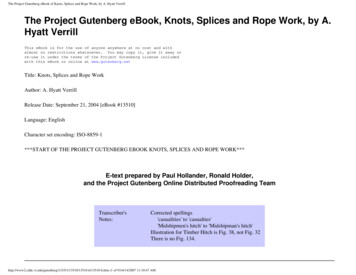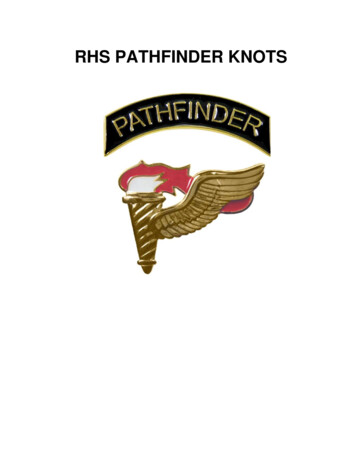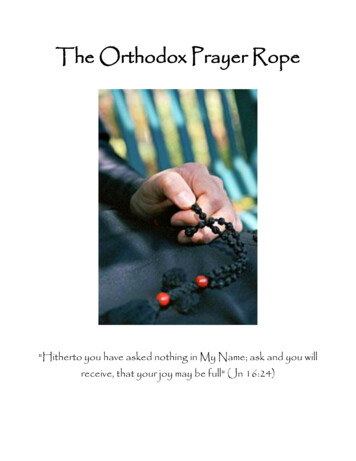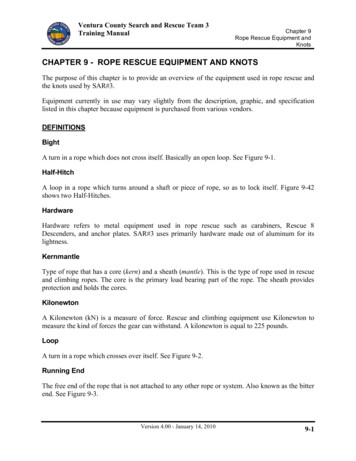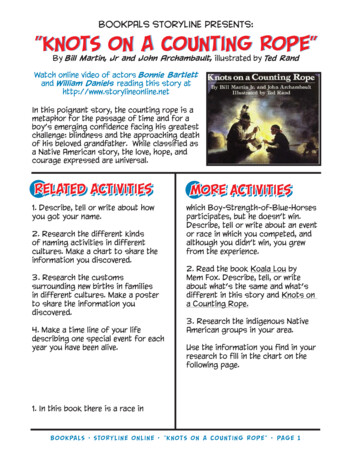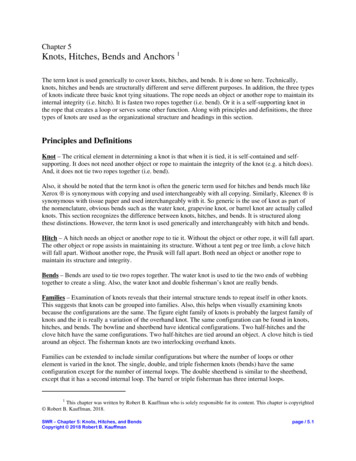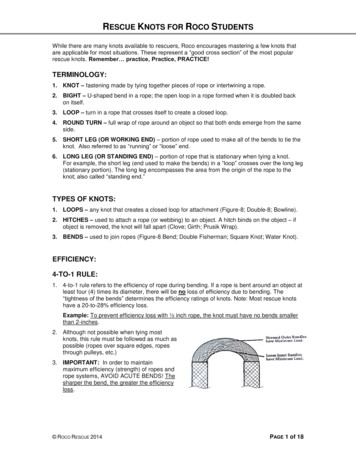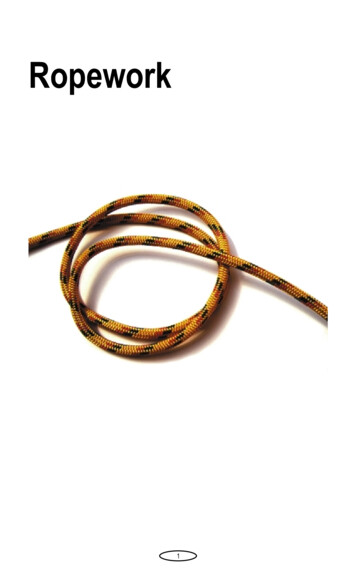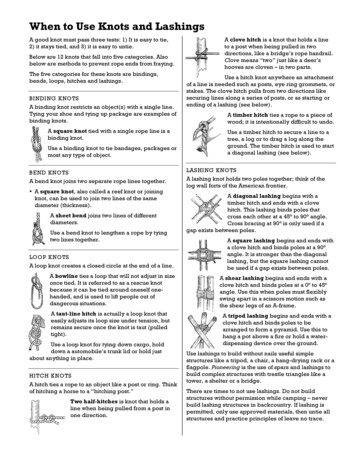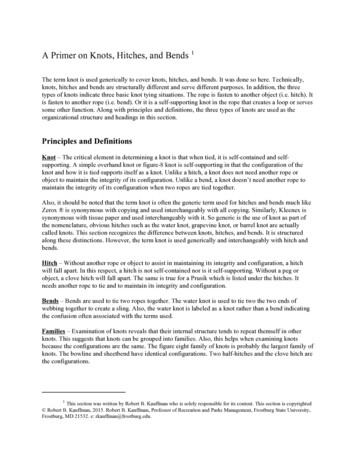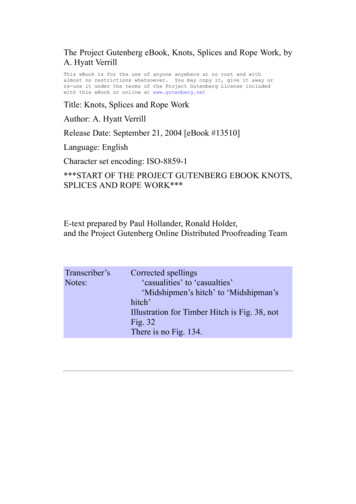
Transcription
The Project Gutenberg eBook, Knots, Splices and Rope Work, byA. Hyatt VerrillThis eBook is for the use of anyone anywhere at no cost and withalmost no restrictions whatsoever. You may copy it, give it away orre-use it under the terms of the Project Gutenberg License includedwith this eBook or online at www.gutenberg.netTitle: Knots, Splices and Rope WorkAuthor: A. Hyatt VerrillRelease Date: September 21, 2004 [eBook #13510]Language: EnglishCharacter set encoding: ISO-8859-1***START OF THE PROJECT GUTENBERG EBOOK KNOTS,SPLICES AND ROPE WORK***E-text prepared by Paul Hollander, Ronald Holder,and the Project Gutenberg Online Distributed Proofreading TeamTranscriber’sNotes:Corrected spellings‘casualities’ to ‘casualties’‘Midshipmen’s hitch’ to ‘Midshipman’shitch’Illustration for Timber Hitch is Fig. 38, notFig. 32There is no Fig. 134.
KNOTS, SPLICES and ROPEWORK
A PRACTICAL TREATISEGiving Complete and Simple Directions for Making All the MostUseful and Ornamental Knots in Common Use, with Chapters onSplicing, Pointing, Seizing, Serving, etc. Adapted for the Use ofTravellers, Campers, Yachtsmen, Boy Scouts, and All OthersHaving to Use or Handle Ropes for Any Purpose.By
A. HYATT VERRILLEditor Popular Science Dept., “American Boy Magazine.”SECOND REVISED EDITIONIllustrated with 156 Original Cuts Showing HowEach Knot, Tie or Splice is Formed and ItsAppearance When Complete.
CONTENTSINTRODUCTIONCHAPTER ICORDAGEKinds of Rope. Construction of Rope. Strength of Ropes. Weightof Ropes. Material Used in Making Ropes.CHAPTER IISIMPLE KNOTS AND BENDSParts of Rope. Whipping and Seizing Rope. Loops. Cuckolds’Necks. Clinches. Overhand and Figure-eight Knots. Square andReef Knots. Granny Knots. Open-hand and Fishermen’s Knots.Ordinary Knots and Weavers’ Knots. Garrick Bends and HawserHitches. Half-hitches.CHAPTER IIITIES AND HITCHESLarks’ Heads. Slippery and Half-hitches. Clove Hitches. Gunners’Knots and Timber Hitches. Twists, Catspaws, and BlackwallHitches. Chain Hitch. Rolling and Magnus Hitches. Studding-sailand Gaff-topsail Halyard Bends. Roband and Fisherman’sHitches.
CHAPTER IVNOOSES, LOOPS, AND MOORING KNOTSWaterman’s Knot. Larks’ Heads with Nooses. Cleat and WharfTies. Bow-line Knots. Loops and Loop Knots.CHAPTER VSHORTENINGS, GROMMETS, AND SELVAGEESTwo-, Three-, and Fivefold Shortenings. Single Plaits and MonkeyChain. Twist Braids and Braiding Leather. Open Chains. Seizedand Bow Shortenings. Sheepshanks and Dogshanks. Grommets.Selvagee Straps and Selvagee Boards. Flemish and ArtificialEyes. Throat Seizings. Lashed Splices.CHAPTER VILASHINGS, SEIZINGS, SPLICES, ETC.Wedding Knots and Rose Lashings. Deadeye and Loop Lashings.Belaying-pin Splice. Necklace Ties. Close Bands and EndPointing. Ending Ropes. Short Splices. Long Splices. Eye and CutSplices.CHAPTER VIIFANCY KNOTS AND ROPE WORKSingle Crown Knots. Tucked Crowns. Single Wall Knots.Common and French Shroud Knots. Double Crown and DoubleWall Knots. Crowning Wall Knots. Double Wall and Crown.Manrope Knots. Topsail-halyard Toggles. Matthew Walker andStopper Knots. Turks’ Heads and Turks’ Caps. Worming,Parcelling, and Serving. Serving Mallet. Half-hitch Work. Fourstrand and Crown Braids. Rope Buckles and Swivels. SlingingCasks and Barrels. Rope Belting.
INDEX
INTRODUCTIONThe history of ropes and knots is so dim and ancient that reallylittle is known of their origin. That earliest man used cordage ofsome kind and by his ingenuity succeeded in tying the materialtogether, is indisputable, for the most ancient carvings anddecorations of prehistoric man show knots in several forms.Doubtless the trailing vines and plants first suggested ropes tohuman beings; and it is quite probable that these same vines, intheir various twistings and twinings, gave man his first idea ofknots.Since the earliest times knots have been everywhere interwovenwith human affairs; jugglers have used them in their tricks; theyhave become almost a part of many occupations and trades, whilein song and story they have become the symbol of steadfastnessand strength.Few realize the importance that knots and cordage have played inthe world’s history, but if it had not been for these simple andevery-day things, which as a rule are given far too littleconsideration, the human race could never have developed beyondsavages. Indeed, I am not sure but it would be safe to state that thereal difference between civilized and savage man consists largelyin the knowledge of knots and rope work. No cloth could bewoven, no net or seine knitted, no bow strung and no craft sailedon lake or sea without numerous knots and proper lines or ropes;and Columbus himself would have been far more handicappedwithout knots than without a compass.History abounds with mention of knots, and in the eighth book of“Odyssey” Ulysses is represented as securing various articles ofraiment by a rope fastened in a “knot closed with Circean art”;and as further proof of the prominence the ancients gave to knotsthe famous Gordian Knot may be mentioned. Probably no one willever learn just how this fabulous knot was tied, and like manymodern knots it was doubtless far easier for Alexander to cut itthan to untie it.The old sorcerers used knots in various ways, and the witches ofLapland sold sailors so-called “Wind Knots,” which were untied
by the sailors when they desired a particular wind. Even modernconjurors and wizards use knots extensively in their exhibitionsand upon the accuracy and manner in which their knots are tieddepends the success of their tricks.In heraldry many knots have been used as symbols and badgesand many old Coats of Arms bear intricate and handsome knots,or entwined ropes, emblazoned upon them.As to the utility of knots and rope work there can be no question.A little knowledge of knots has saved many a life in storm andwreck, and if every one knew how to quickly and securely tie aknot there would be far fewer casualties in hotel and similar fires.In a thousand ways and times a knowledge of rope and knots isuseful and many times necessary. Many an accident has occurredthrough a knot or splice being improperly formed, and even intying an ordinary bundle or “roping” a trunk or box few people tiea knot that is secure and yet readily undone and quickly made. Ina life of travel and adventure in out-of-the-way places, in yachtingor boating, in hunting or fishing, and even in motoring, tocommand a number of good knots and splices is to make lifesafer, easier, and more enjoyable, aside from the real pleasure onemay find in learning the interesting art of knot-tying.Through countless ages the various forms of knots and fasteningsfor rope, cable, or cord have been developed; the best kinds beingsteadily improved and handed down from generation togeneration, while the poor or inferior fastenings have beendiscarded by those whose callings required the use of cordage.Gradually, too, each profession or trade has adopted the knots bestsuited to its requirements, and thus we find the Sailor’s Knot; theWeaver’s Knot; Fishermen’s knots; Builders’ knots; Butchers’knots; and many others which have taken their names from the useto which they are especially adapted.In addition to these useful knots, there are many kinds ofornamental or fancy knots used in ornamenting the ends of ropes,decorating shrouds of vessels, railings, and similar objects; whilecertain braids or plaits, formed by a series of knots, are widelyused aboard ship and on land.In many cases ropes or cable must be joined in such a way thatthey present a smooth and even surface and for such purposessplices are used, while knots used merely as temporary fastenings
and which must be readily and quickly tied and untied arecommonly known as “bends” or “hitches.” Oddly enough, it is fareasier to tie a poor knot than a good one, and in ninety-nine casesout of a hundred the tyro, when attempting to join two ropestogether, will tie either a “slippery” or a “jamming” knot and willseldom succeed in making a recognized and “ship-shape” knot ofany sort.The number of knots, ties, bends, hitches, splices, and shorteningsin use is almost unlimited and they are most confusing andbewildering to the uninitiated. The most useful and ornamental, aswell as the most reliable, are comparatively few in number, and inreality each knot learned leads readily to another; in the followingpages I have endeavored to describe them in such a manner thattheir construction may be readily understood and mastered.THE AUTHOR.JANUARY, 1917.
CHAPTER ICORDAGEBefore taking up the matter of knots and splices in detail it may bewell to give attention to cordage in general. Cordage, in itsbroadest sense, includes all forms and kinds of rope, string, twine,cable, etc., formed of braided or twisted strands.In making a rope or line the fibres (A, Fig. 1) of hemp, jute,cotton, or other material are loosely twisted together to form whatis technically known as a “yarn” (B, Fig. 1). When two or moreyarns are twisted together they form a “strand” (C, Fig. 1). Threeor more strands form a rope (D, Fig. 1), and three ropes form acable (E, Fig. 1). To form a strand the yarns are twisted together inthe opposite direction from that in which the original fibres weretwisted; to form a rope the strands are twisted in the oppositedirection from the yarns of the strands, and to form a cable eachrope is twisted opposite from the twist of the strands. In this waythe natural tendency for each yarn, strand, or rope to untwistserves to bind or hold the whole firmly together (Fig. 1).
Rope is usually three-stranded and the strands turn from left toright or “with the sun,” while cable is left-handed or twisted“against the sun” (E, Fig. 1). Certain ropes, such as “bolt-rope”and most cables, are laid around a “core” (F, Fig. 2) or centralstrand and in many cases are four-stranded (Fig. 2).The strength of a rope depends largely upon the strength andlength of the fibres from which it is made, but the amount eachyarn and strand is twisted, as well as the method used in bleachingor preparing the fibres, has much to do with the strength of thefinished line.Roughly, the strength of ropes may be calculated by multiplyingthe circumference of the rope in inches by itself and the fifth partof the product will be the number of tons the rope will sustain. Forexample, if the rope is 5 inches in circumference, 5 X 5 25, onefifth of which is 5, the number of tons that can safely be carried ona 5-inch rope. To ascertain the weight of ordinary “right hand”rope, multiply the circumference in inches by itself and multiply,the result by the length of rope in fathoms and divide the productby 3.75. For example, to find the weight of a 5-inch rope, 50fathoms in length: 5 X 5 25; 25 x 50 1,250; 1,250 3.75 333-1/3 lbs. These figures apply to Manila or hemp rope, which isthe kind commonly used, but jute, sisal-flax, grass, and silk arealso used considerably. Cotton rope is seldom used save for small
hand-lines, clothes-lines, twine, etc., while wire rope is largelyused nowadays for rigging vessels, derricks, winches, etc., but assplicing wire rope is different from the method employed in fibrerope, and as knots have no place in wire rigging, we will notconsider it.
CHAPTER IISIMPLE KNOTS AND BENDSFor convenience in handling rope and learning the various knots,ties, and bends, we use the terms “standing part,” “bight,” and“end” (Fig. 3). The Standing Part is the principal portion orlongest part of the rope; the Bight is the part curved or bent whileworking or handling; while the End is that part used in formingthe knot or hitch. Before commencing work the loose ends orstrands of a rope should be “whipped” or “seized” to prevent therope from unravelling; and although an expert can readily tiealmost any knot, make a splice, or in fact do pretty nearlyanything with a loose-ended rope, yet it is a wise plan toinvariably whip the end of every rope, cable, or hawser to behandled, while a marline-spike, fid, or pointed stick will alsoprove of great help in working rope.
To whip or seize a rope-end, take a piece of twine or string and layit on the rope an inch or two from the end, pass the twine severaltimes around the rope, keeping the ends of the twine under thefirst few turns to hold it in place; then make a large loop with thefree end of twine; bring it back to the rope and continue windingfor three or four turns around both rope and end of twine; and thenfinish by drawing the loop tight by pulling on the free end (Fig. 4).
All knots are begun by “loops” or rings commonly known tomariners as “Cuckolds’ Necks” (Fig. 5).These may be either overhand or underhand, and when a seizingor fastening of twine is placed around the two parts where theycross a useful rope ring known as a “clinch” is formed (Fig. 6).If the loose end of the rope is passed over the standing part andthrough the “cuckold’s-neck,” the simplest of all knots, known asthe “Overhand Knot,” is made (Fig. 7). This drawn tight appears
as in Fig. 8, and while so simple this knot is important, as it isfrequently used in fastening the ends of yarns and strands insplicing, whipping, and seizing.The “Figure-Eight Knot” is almost as simple as the overhand andis plainly shown in Figs. 9 and 10.Only a step beyond the figure-eight and the overhand knots are the“Square” and “Reefing” knots (Figs. 11 and 12). The square knotis probably the most useful and widely used of any common knotand is the best all-around knot known. It is very strong, never slipsor becomes jammed, and is readily untied. To make a square knot,take the ends of the rope and pass the left end over and under theright end, then the right over and under the left.
If you once learn the simple formula of “Left over,” “Right over,”you will never make a mistake and form the despised “Granny,” amost useless, bothersome, and deceptive makeshift for anypurpose (Fig. 13). The true “Reef Knot” is merely the square knotwith the bight of the left or right end used instead of the end itself.This enables the knot to be “cast off” more readily than the regularsquare knot (A, Fig. 12).Neither square nor reef knots, however, are reliable when tyingtwo ropes of unequal size together, for under such conditions theywill frequently slip and appear as in Fig. 14, and sooner or laterwill pull apart.
To prevent this the ends may be tied or seized as shown in Fig. 15.
A better way to join two ropes of unequal diameter is to use the“Open-hand Knot.” This knot is shown in Fig. 16, and is veryquickly and easily made; it never slips or gives, but is rather largeand clumsy, and if too great a strain is put on the rope it is morelikely to break at the knot than at any other spot.The “Fisherman’s Knot,” shown in Fig. 17, is a good knot and isformed by two simple overhand knots slipped over each rope, andwhen drawn taut appears as in Fig. 18.This is an important and valuable knot for anglers, as the two linesmay be drawn apart by taking hold of the ends, A, B, and a thirdline for a sinker, or extra hook, may be inserted between them. Injoining gut lines the knot should be left slightly open and thespace between wrapped with silk. This is probably the strongestknown method of fastening fine lines.
The “Ordinary Knot,” for fastening heavy ropes, is shown in Fig.19.It is made by forming a simple knot and then interlacing the otherrope or “following around,” as shown in Fig. 20. This knot is verystrong, will not slip, is easy to make, and does not strain the fibresof the rope. Moreover, ropes joined with this knot will pay out, orhang, in a straight line.
By whipping the ends to the standing parts it becomes a neat andhandsome knot (Fig. 21).The “Weaver’s Knot” (Fig. 22) is more useful in joining smalllines, or twine, than for rope, and for thread it is without doubt thebest knot known.
The ends are crossed as in Fig. 23. The end A is then looped backover the end B, and the end B is slipped through loop C and drawntight.Another useful and handsome knot is illustrated in Fig. 24. This isa variation of the figure-eight knot, already described, and is usedwhere there is too much rope, or where a simple knot is desired toprevent the rope running through an eye, ring, or tackle-block.
It is made by forming a regular figure eight and then “followinground” with the other rope as in Fig. 25. It is then drawn taut andthe ends seized to the standing part if desired.Sometimes we have occasion to join two heavy or stiff ropes orhawsers, and for this purpose the “Garrick Bend” (Fig. 26) ispreeminently the best of all knots. To make this knot, form a bightby laying the end of a rope on top of and across the standing part.Next take the end of the other rope and pass it through this bight,first down, then up, over the cross and down through the bightagain, so that it comes out on the opposite side from the other end,thus bringing one end on top and the other below, as illustrated inFig. 27. If the lines are very stiff or heavy the knot may be securedby seizing the ends to the standing parts.
A much simpler and a far poorer knot is sometimes used infastening two heavy ropes together. This is a simple hitch within aloop, as illustrated in Fig. 28, but while it has the advantage ofbeing quickly and easily tied it is so inferior to the Garrick bendthat I advise all to adopt the latter in its place.When two heavy lines are to be fastened for any considerabletime, a good method is to use the “Half-hitch and Seizing,” shownin Fig. 29. This is a secure and easy method of fastening ropestogether and it allows the rope to be handled more easily, and topass around a winch or to be coiled much more readily, than whenother knots are used.
CHAPTER IIITIES AND HITCHESAll the knots I have so far described are used mainly for fasteningthe two ends of a rope, or of two ropes, together. Of quite adifferent class are the knots used in making a rope fast to astationary or solid object, and are known as “hitches” or “ties.”
One of the easiest of this class to make and one which is veryuseful in fastening a boat or other object where it may benecessary to release it quickly is the “Lark’s Head” (Fig. 30). Tomake this tie, pass a bight of your rope through the ring, or otherobject, to which you are making fast and then pass a marlinespike, a billet of wood, or any similar object through the sides ofthe bight and under or behind the standing part, as shown in A,Fig. 30.The end of the rope may then be laid over and under the standingpart and back over itself. This knot may be instantly released bymerely pulling out the toggle.
Almost as quickly made and unfastened is the “Slippery Hitch”(Fig. 32).
To make this, run the end of the rope through the ring or eye towhich it is being fastened, then back over the standing part andpull a loop, or bight, back through the “cuckold’s neck” thusformed (Fig. 33). To untie, merely pull on the free end.
Two half-hitches, either around a post or timber or around thestanding part of the rope, make an ideal and quickly tied fastening(Figs. 34 and 35). To make these, pass the end around the post,ring, or other object, then over and around the standing partbetween the post and itself, then under and around the standingpart and between its own loop and the first one formed. After alittle practice you can tie this knot almost instantly and by merelythrowing a couple of turns around a post, two half-hitches may beformed instantly. This knot will hold forever without loosening,and even on a smooth, round stick or spar it will stand anenormous strain without slipping.
A more secure knot for this same purpose is the “Clove Hitch”(Fig. 36), sometimes known as the “Builders’ Hitch.”To make this, pass the end of rope around the spar or timber, thenover itself; over and around the spar, and pass the end under itselfand between rope and spar, as shown in the illustration.
The Clove hitch with ends knotted becomes the “Gunners’ Knot”(Fig. 37). These are among the most valuable and important ofknots and are useful in a thousand and one places. The Clove hitchwill hold fast on a smooth timber and is used extensively bybuilders for fastening the stageing to the upright posts. It is alsouseful in making a tow-line fast to a wet spar, or timber, and evenon a slimy and slippery spile it will seldom slip.
For this purpose the “Timber Hitch” (Fig. 38) is even better thanthe Clove hitch. It is easily made by passing the end of a ropearound the spar or log, round the standing part of the rope andthen twist it three or more times around, under and over itself.If you wish this still more secure, a single half-hitch may be takenwith the line a couple of feet further along the spar (Fig. 39).
It is remarkable what power to grip a twisted rope has, and the“Twist Knots” shown in Figs. 40 and 41 illustrate two ways ofmaking fast which are really not knots at all but merely twists.These may be finished by a simple knot, or a bow-knot, as shownin Fig. 42, but they are likely to jam under great pressure and are
mainly useful in tying packages, or bundles, with small cord,where the line must be held taut until the knot is completed.This principle of fastening by twisted rope is also utilized in the“Catspaw” (Fig. 43), a most useful knot or “hitch” for hoistingwith a hook.
To make this, pass the bight of your rope over the end andstanding part, then, with a bight in each hand, take three twistsfrom you, then bring the two bights side by side and throw overthe hook (Fig. 44).
The “Blackwall Hitch” (Fig. 45) is still simpler and easier to makeand merely consists of a loop, or cuckold’s neck, with the end ofrope passed underneath the standing part and across the hook sothat as soon as pressure is exerted the standing part bears on theend and jams it against the hook.The “Chain Hitch” (Fig. 46) is a very strong method of fastening aline to a timber, or large rope, where one has a rope of sufficient
length, and is used frequently to help haul in a large rope or forsimilar purposes.It consists simply of a number of half-hitches taken at intervalsaround the object and is sometimes used with a lever orhandspike, as shown in Fig. 47.
The “Rolling Hitch” is a modified Clove hitch and is shown inFig. 48.The “Magnus Hitch” (Fig. 49) is a method frequently used onshipboard for holding spars;
and the “Studding-sail Bend” (Fig. 50) is also used for thispurpose.Occasions sometimes arise where a tackle, hook, ring, or anotherrope must be fastened to a beam by the same rope being used, andin such cases the “Roband Hitch” (Fig. 51) comes in very handy.
These are all so simple and easily understood from the figures thatno explanation is necessary.
Almost as simple are the “Midshipman’s Hitch” (Fig. 52), the“Fisherman’s Hitch” (Fig. 53), and the “Gaff Topsail HalyardBend” (Fig. 54). The midshipman’s hitch is made by taking a halfhitch around the standing part and a round turn twice aroundabove it.
The fisherman’s hitch is particularly useful in making fast largehawsers; with the end of a rope take two turns around a spar, orthrough a ring; take a half-hitch around the standing part andunder all the turns; then a half-hitch round the standing part onlyand if desired seize the end to standing part.The gaff-topsail bend is formed by passing two turns around theyard and coming up on a third turn over both the first two turns;over its own part and one turn; then stick the end under the firstturn.
CHAPTER IVNOOSES, LOOPS AND MOORING KNOTSNothing is more interesting to a landsman than the manner inwhich a sailor handles huge, dripping hawsers or cables and witha few deft turns makes then fast to a pier-head or spile, in such away that the ship’s winches, warping the huge structure to or fromthe dock, do not cause the slightest give or slip to the rope and yet,a moment later, with a few quick motions, the line is cast off,tightened up anew, or paid out as required.Clove hitches, used as illustrated in Fig. 55, and known as the“Waterman’s Knot,” are often used, with a man holding the freeend, for in this way a slight pull holds the knot fast, while a littleslack gives the knot a chance to slip without giving way entirelyand without exerting any appreciable pull on the man holding theend.
“Larks’ Heads” are also used in conjunction with a running noose,as shown in Fig. 56,
while a few turns under and over and around a cleat, or about twospiles, is a method easily understood and universally used bysailors (Fig. 57).
The sailor’s knot par excellence, however, is the “Bow-line” (Fig.58), and wherever we find sailors, or seamen, we will find thisknot in one or another of its various forms. When you can readilyand surely tie this knot every time, you may feel yourself on theroad to “Marline-spike Seamanship,” for it is a true sailor’s knotand never slips, jams, or fails; is easily and quickly untied, and isuseful in a hundred places around boats or in fact in any walk oflife.
The knot in its various stages is well shown in Fig. 59 and byfollowing these illustrations you will understand it much betterthan by a description alone. In A the rope is shown with a bight orcuckold’s neck formed with the end over the standing part. Pass Aback through the bight, under, then over, then under, as shown inB, then over and down through the bight, as shown in C and D,and draw taut, as in E.
The “Bow-line on a Bight” (Fig 60) is just as easily made and isvery useful in slinging casks or barrels and in forming a seat formen to be lowered over cliffs, or buildings, or to be hoisted aloftaboard ship for painting, cleaning, or rigging.
A “Running Bow-line” (Fig. 61) is merely a bow-line with the endpassed through the loop, thus forming a slip knot.
Other “Loops” are made as shown in Figs. 62-65, but none ofthese are as safe, sure, and useful as the bow-line.One of these knots, known as the “Tomfool Knot” (Fig. 66), isused as handcuffs and has become quite famous, owing to itshaving baffled a number of “Handcuff Kings” and otherperformers who readily escaped from common knots andmanacles. It is made like the running knot (Fig. 62), and the firmend is then passed through the open, simple knot so as to form adouble loop or bow. If the hands or wrists are placed withinthese loops and the latter drawn taut, and the loose ends tiedfirmly around the central part, a pair of wonderfully securehandcuffs results.
CHAPTER VSHORTENINGS, GROMMETS, AND SELVAGEESIn many cases a rope may prove too long for our use or the freeends may be awkward, or in the way. At such times a knowledgeof “shortenings” is valuable. There are quite a variety of theseuseful knots, nearly all of which are rather handsome andornamental, in fact a number of them are in constant use aboardship merely for ornament.The simplest form of shortening, shown in Fig. 67, is a variationof the common and simple overhand knot already described andillustrated.
These knots are formed by passing the end of a rope twice ormore times through the loop of the simple knot and thendrawing it tight (Fig. 68). They are known as “Double,”“Treble,” “Fourfold,” or “Sixfold” knots and are used to preventa rope from passing through a ring or block as well as forshortening.All gradations from the double to the sixfold are shown in Fig.69, both in process of making and as they appear when drawntaut.
Another very simple form of shortening is shown in Fig. 70 andis known as the “Single Plait,” or “Chain Knot.” To make thisshortening, make a running loop (A, Fig. 70), then draw a bightof the rope through this loop, as shown at B, draw another bightthrough this, as at C to D, and continue in this way until the ropeis shortened to the desired length; the free end should then be
fastened by passing a bit of stick through the last loop, F, or byrunning the free end through the last loop, as at E.To undo this shortening, it is only necessary to slip out the freeend, or the bit of wood, and pull on the end, when the entire knotwill quickly unravel.
The “Twist,” or “Double Chain,” is made in a similar mannerbut is commenced In a different way (A, Fig. 71). It may also bemade with three separate pieces of line, as shown in B, Fig. 71.Hold the double loop in the left hand; the part A is then broughtover B; with a half turn B is crossed over to A, and then proceedas in the ordinary three-strand plait until the end of loop isreached, when the loose end is fastened by passing through thebight and the completed shortening appears as in Fig. 72.
This same process is often used by Mexicans and Westerners inmaking bridles, headstalls, etc., of leather. The leather to be usedis slit lengthwise from near one end to near the other, as shownin Fig. 73, and the braid is formed as described.The result appears as in Fig. 74, and in this way the ends of theleather strap remain uncut, and thus much stronger and neaterthan they would be were three separate strips used.Another handsome knot for shortening is the more highlyornamental “Open Chain” (Fig. 75). Make the first loop of therope secure by a twist of the rope and then pass the loose endthrough the preceding loop, to right and left alternately, until theknot is complete.
The simplest of all shortenings consists of a loop taken in therope with the bights seized to the standing part (Fig. 76). This isparticularly well adapted to heavy rope or where a shorteningmust be made quickly.Fig. 77 shows another very simple shortening, which requires nodescription. This will not withstand a very great strain but issecure from untying by accident and is very useful for taking upspare rope of lashings on bundles or baggage.“Sheepshanks,” or “Dogshanks,” are widely used for shorteningrope, especially where both ends are fast, as they can be readilymade in the centre of a tied rope. There
Title: Knots, Splices and Rope Work Author: A. Hyatt Verrill Release Date: September 21, 2004 [eBook #13510] Language: English Character set encoding: ISO-8859-1 ***START OF THE PROJECT GUTENBERG EBOOK KNOTS, SPLICES AND ROPE WORK*** E-text prepared by Paul Hollander, Ronald Holder, and th
